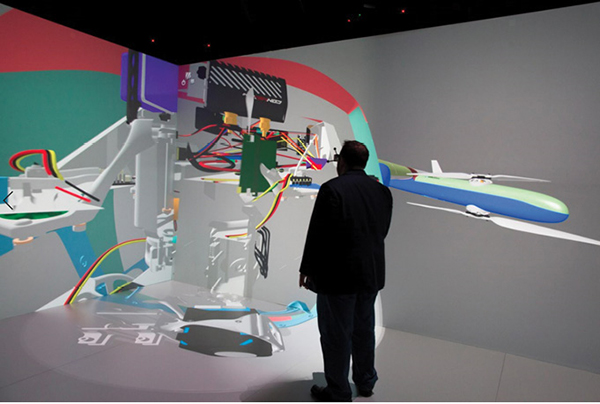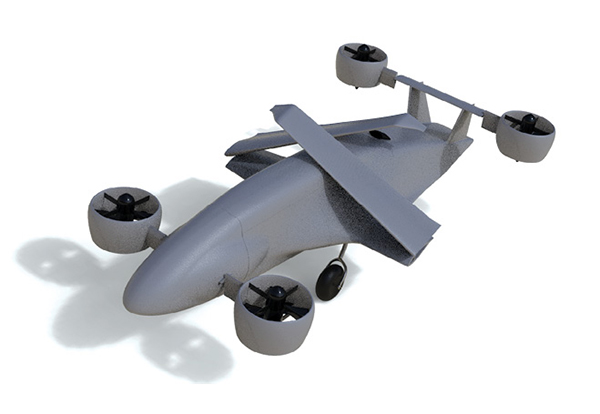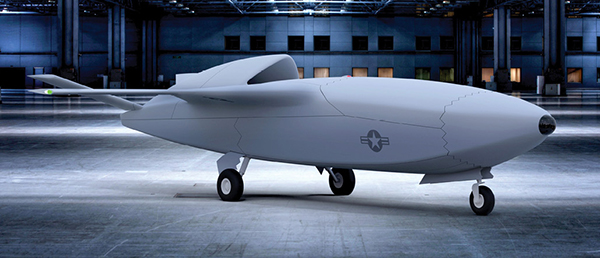Engineering Automation: Going on Autopilot
From flying taxis to cargo drones, efforts are underway to automate in the air.

Image courtesy of Volocopter.
Design Exploration and Optimization News
Design Exploration and Optimization Resources


Dassault Systemes

Latest News
May 1, 2019
While automakers, governments and consumers grapple with what roadways will look like once self-driving cars arrive en masse, many companies are already looking ahead to what could be the next big movement in autonomous transportation: autonomous aircraft that can move both cargo and people.
Dozens of companies, from large players such as Airbus, Boeing and Uber, to small startups that are designing vertical-lift air taxis and other types of planes, are targeting the market.
Airbus has established a flying taxi testing ground in Oregon, and its CityAirbus project could demonstrate flight for its urban mobility system this year, with a fully electric 2.2-tonne aircraft. Bell has also developed an electronic vertical take-off and landing (eVTOL) using a hybrid fuel-electric approach. Boeing acquired eVTOL company Aurora and has also created an autonomous air vehicle research center in Cambridge, MA.
In January, Boeing completed its first successful test flight of an autonomous passenger air vehicle prototype in Virginia. Aurora Flight Sciences designed and developed the eVTOL (part of the Boeing NeXt division), which was able to complete a controlled takeoff, hover and landing. Planned future tests will evaluate forward flight, and the transition phase between vertical and forward-flight modes.
The current prototype has an electric propulsion system and can achieve fully autonomous flight with a range of 50 miles, according to the company. The NeXt division also oversees Boeing’s heavy-duty drone prototype, which can lift a 500-lb. cargo payload.
Dassault Systèmes is specifically targeting electric aircraft and sustainable air mobility through its Sky initiative. Dassault is already working with a number of aerospace companies, including air taxi startup Joby Aviation and electric passenger jet designer EViation.
“There’s a lot of consumer interest, and we’ve seen a lot of startups investigate this air taxi space,” says Eric Seiberling, geo marketing leader for North America at Dassault. “We’re creating a solution that helps them cut time and development effort, and helps them get through conceptual testing and early prototyping.”
To be financially viable, air taxis almost have to be pilot-less—having a pilot in the craft eats up 25% to 50% of the possible passenger load, not to mention the worldwide pilot shortage. Most of these projects involve small, two-to-four-seater aircraft with electric or hybrid power sources that are designed for short-hop flights.
German company Volocopter, for example, is working with Fraport, the management entity in charge of the Frankfurt Airport, to develop plans for a potential air taxi port and hub that can link commuters to various transportation points across the city, and then to the airport.
Although consumers are not quite ready for autonomous aircraft, there is already a degree of autonomy in modern passenger and military aircraft that has helped reduce pilot workloads.
“The level of automation we have already reached is very high,” says Paolo Colombo, global industry director, Aerospace and Defense at ANSYS. “In a typical commercial flight, pilots pull the data into the flight computer and then spend most of the time monitoring the aircraft systems, letting the autopilot manage the flight. Manual controls are used usually just during takeoff, landing or if an anomaly is detected, and even in these phases the inputs pilots give to flight controls and engines through stick and throttle are processed by the fly-by-wire or the FADEC (Full Authority Digital Engine Control) to keep the aircraft safely into its flight envelope.”

In addition to air taxi services, some startups are targeting small cargo applications and flight training.
We could see flights begin sooner rather than later, according to Siemens AG spokesperson Florian Martini. “Flight training applications have already begun, and will become commonplace within the next few years,” Martini says. “Commercial transport applications will follow in the early 2020s.”
Autonomous Flight Challenges
Autonomous systems have a number of traditional engineering requirements to satisfy that are common to manned and unmanned aircraft. Endurance is a key criterion and affects a range of design considerations that are mostly electrical or new to the industry, such as materials and structural optimization, aerodynamics, electronics and propulsion systems, according to Colombo.
The need for unconventional shapes pushes designers to explore ideas that must be validated in a range of conditions including wind gusts and turbulence. Noise produced by the system must be considered as well, as it can have an effect on acceptability and certification for urban missions.
“A self-flying vehicle must also be able to sense, think and act with levels of autonomy much higher than [what’s] traditionally available,” Colombo says.
That means the aircraft must be outfitted with a number of sensors that eat up minimal amounts of energy. As with self-driving cars, aircraft manufacturers will need to prove that these planes can safely fly in populated areas.
Power density is an ongoing issue as well, as companies struggle to find batteries that can supply sufficient energy without adding too much weight.
“We [are] doing a lot of investigation into batteries that we can use in our hybrid configuration,” says Ed De Reyes, CEO of Sabrewing, which is developing autonomous and semi-autonomous cargo drones. “New battery technology is really critical.”
Dassault’s Seiberling says that certifications will be a big challenge for these companies moving forward.
“How do these companies get through that process, and document and submit everything to the FAA (Federal Aviation Administration) or other authorities to capture all of the required data?” he asks.
Noise reduction is another hurdle, particularly for companies that are targeting the urban air taxi space. Existing regulations govern where and how helicopters operate in cities; an influx of air taxis can create new noise pollution issues, as well as flight path and congestion problems.
Because prototypes and flight tests are expensive, simulation will play a big role in the development of these systems.
“Embedded software is a key differentiator as it represents the intelligence of the system, but its generation and testing under all the possible scenarios is becoming increasingly complex,” Colombo says. “These considerations must be balanced against the requirements for robustness, reliability and cost. And of course, it must be demonstrated that the drone can comply with the relevant safety and regulatory requirements.
“This can represent years of engineering and testing, even for a large engineering team. And this is where simulation helps today, with a multiphysics approach that can consider all these phenomena together to drastically decrease the number of physical tests and support the product development and certification,” he adds.
Simulating the Future of Pilot-less Flight
That need for faster testing access and simulation capabilities is what drove the development of the Reinvent the Sky initiative. Dassault’s program has helped its customers create and optimize large numbers of design concepts simultaneously, which streamlines the design space exploration process.
“You can set up model-based systems engineering and iterate very quickly, using the technology we have, and that cuts out a significant amount of time,” Seiberling says.
“Our 3DEXPERIENCE platform allows all of the different functions inside the smaller OEMs (original equipment manufacturers) to collaborate, as well as collaborate with partners and suppliers, and share models in real time,” he adds.
Volocopter spent 10 months making calculations to confirm that manned electrical vertical flight was possible, and it took roughly a year to design the first prototype prior to the initial manned flight test in 2011, according to co-founder Alex Zosel. With several years of flight test data now available, the company is making improvements via simulation.
“We have the opportunity to integrate the data we have collected in hundreds of flights with our 1:1 prototypes into the simulation tools and software to make them ever better for our testing purposes. As a result, our simulation tools offer us extremely realistic results for the further development of our flight systems,” Zosel says.
Sabrewing has conducted extensive finite element analysis and computational fluid dynamics simulations on its two autonomous cargo aircraft designs, along with independent verification and validation. The company has also used X-Plane for flight simulation.
Between Sabrewing’s internal team and its partners, there are nearly four dozen engineers currently working on the project.
Beyond the standard safety tests on the aerostructure, propulsion and system design, it’s important to ensure that the aircraft is able to sense, decide and take safe actions in any situation that can range from traffic and weather avoidance to system malfunction management.
“This requires simulating sensors, software and controls in a loop and in a virtual scenario that creates challenges for the system,” ANSYS’ Colombo says. “We started doing that for autonomous driving cars, because it is impossible to physically test their systems as it will require to make them drive for more than 8 billion miles, taking hundreds of years, and we have extended our platform to test aircraft and drones.”
“Simulation is the only way to manage this complexity at a cost and within a time frame that gives these project chances to succeed,” Colombo adds. “Aerospace and defense companies believe they have entered an era of technology advancement that is no longer marked by linear progression, but by an exponential rate of change, and there is a consensus that digital transformation, of which simulation is a key enabler, is a critical part of how they can cope with it.”
How 3D Printing Enables Electric Flight
3D printing is also simplifying manufacture of the aircraft and reducing weight, which is especially important for hybrid and electric aircraft.
Sabrewing is using two 3D printers that work in conjunction to print the parts for both its scale models and the full-size prototype that is currently under construction.
“For parts that are too large for one printer, we can split them and have dual printers running at the same time to produce the parts we need,” De Reyes says. “We have quite a bit of 3D printing throughout the plane, including for our ducted fans. We can get super high tolerance parts using that process for the fans.”


The Sabrewing aircraft have a frame made of composite tubes on which skins can be attached. If the skins are damaged, they can easily be replaced or repaired in the field.
“Particularly for these smaller companies, 3D printing helps get them to the first prototype without needing to spend time setting up to do traditional milling and other processes,” Seiberling says. “The entire industry is looking at how to get additive out of the lab and into the production floor to make certified parts.”
Regulations Still in Flux
Exactly how autonomous aircraft will be regulated and controlled remains to be seen. Although unmanned applications like cargo transport can fall under existing FAA and other regulations that govern the use of drones, autonomous aircraft that will carry passengers will require licensing by relevant aviation authorities, as well as the development of new types of air traffic policies and controls for both airports and municipalities.
The Sabrewing cargo craft will fall under FAA Part 23, which covers anything under 12,500 lbs. “We’ve had a great response from the FAA,” De Reyes says. “We’re sharing 100% of our data with them, and figuring out together how these aircraft will be certified in the future.”
“There are estimates that there could be in the neighborhood of 100 take-offs per hour or more than that,” Seiberling says. “The sheer volume of air taxis could be a major problem. And where do you park and land these craft, not just in an airport but in other locations around a city? What if there is an emergency landing? These are all things that have to be sorted out before autonomous air taxis become a reality.”
In the meantime, autonomous air cargo will likely see more movement over the next few years. Cargo flights don’t present the same level of safety issues—there are no passengers to consider—and can operate in relatively unpopulated ground and air space, delivering goods to rural airports or even to areas that have no airports. That’s a key part of Sabrewing’s business model—the company is targeting military, disaster relief and other applications where cargo needs to delivered to remote areas.
It will still be a long time before we see autonomous aircraft hovering around major cities. The furor around autonomous car accidents raised additional concerns among consumers and lawmakers; a drone laden with 1,000 lbs. of cargo crash landing in the middle of a city is a disaster that nobody wants to risk.
There are other areas of opposition as well. Efforts to allow single-pilot cargo flights augmented by automation are already opposed by the Airline Pilots Associations. And automation appears to have played a significant role in the Boeing 737 Max 8 jet crashes that grounded flights around the world.
“This is actually a key question as we are missing [much] information about how to certify autonomous systems, which are the key requirements to make them fly and also how they can interact with other traffics in controlled airspaces,” Colombo says. “I think that many of the companies that are developing technologies in this field are waiting for these clarifications. When they will come, we will see the real race to autonomy starting.”
More Ansys Coverage
More Dassault Systemes Coverage

More Siemens Digital Industries Software Coverage
Subscribe to our FREE magazine, FREE email newsletters or both!
Latest News
About the Author
Brian Albright is the editorial director of Digital Engineering. Contact him at de-editors@digitaleng.news.
Follow DERelated Topics





